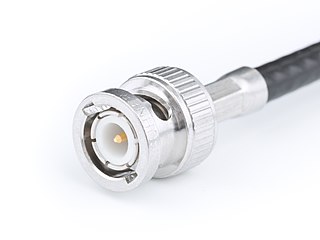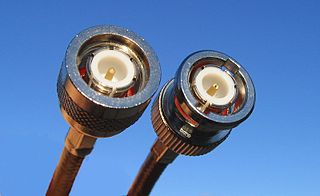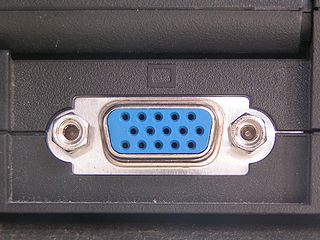A concentric twinax connector has a center pin (signal high) and a cylindrical intermediate contact (signal low) as compared to a dual polarized pin type.
Contents
These connectors are also used for connecting Triaxial cable.

A concentric twinax connector has a center pin (signal high) and a cylindrical intermediate contact (signal low) as compared to a dual polarized pin type.
These connectors are also used for connecting Triaxial cable.

| | This section is empty. You can help by adding to it. (July 2010) |
Since MIL-STD-1553B does not specify the type of connector to be employed in data bus applications, the connectors must be compatible with cable delineated in the specification. However, specific military connector specifications are relevant or have evolved as a result of data bus applications. The primary applicable specifications are MIL-C-39012 (relative to RF coaxial connectors such as BNC, N, etc.), MIL-C-49142 (related to concentric twinax/triax connectors) and MIL-DTL-38999 (related to military type cylindrical connectors).
One of the most popular types of connectors used on the data bus is the concentric twinax bayonet style. These connectors are available in standard (BNC size), miniature and subminiature sizes. Furthermore, connectors are offered in various solder/clamp and crimp assembly versions. Connector interface models are 2-, 3- and 4-lug bayonet as well threaded. Special pin and socket, keying and polarization are also offered.

The BNC connector is a miniature quick connect/disconnect radio frequency connector used for coaxial cable. It is designed to maintain the same characteristic impedance of the cable, with 50 ohm and 75 ohm types being made. It is usually applied for video and radio frequency connections up to about 2 GHz and up to 500 volts. The connector has a twist to lock design with two lugs in the female portion of the connector engaging a slot in the shell of the male portion. The type was introduced on military radio equipment in the 1940s and has since become widely applied in radio systems, and is a common type of video connector. Similar radio-frequency connectors differ in dimensions and attachment features, and may allow for higher voltages, higher frequencies, or three-wire connections.

The N connector is a threaded, weatherproof, medium-size RF connector used to join coaxial cables. It was one of the first connectors capable of carrying microwave-frequency signals, and was invented in the 1940s by Paul Neill of Bell Labs, after whom the connector is named.

The TNC connector is a threaded version of the BNC connector.

RS-422, also known as TIA/EIA-422, is a technical standard originated by the Electronic Industries Alliance, first issued in 1975, that specifies electrical characteristics of a digital signaling circuit. It was meant to be the foundation of a suite of standards that would replace the older RS-232C standard with standards that offered much higher speed, better immunity from noise, and longer cable lengths. RS-422 systems can transmit data at rates as high as 10 Mbit/s, or may be sent on cables as long as 1,200 meters (3,900 ft) at lower rates. It is closely related to RS-423, which uses the same signaling systems but on a different wiring arrangement.

In electronics, electrical termination is the practice of ending a transmission line with a device that matches the characteristic impedance of the line. Termination prevents signals from reflecting off the end of the transmission line. Reflections at the ends of unterminated transmission lines cause distortion, which can produce ambiguous digital signal levels and misoperation of digital systems. Reflections in analog signal systems cause such effects as video ghosting, or power loss in radio transmitter transmission lines.

The Video Graphics Array (VGA) connector is a standard connector used for computer video output. Originating with the 1987 IBM PS/2 and its VGA graphics system, the 15-pin connector went on to become ubiquitous on PCs, as well as many monitors, projectors and high-definition television sets.

The C connector is a type of RF connector used for terminating coaxial cable. The interface specifications for the C and many other connectors are referenced in MIL-STD-348. The connector uses two-stud bayonet-type locks. The C connector was invented by Amphenol engineer Carl Concelman. It is weatherproof without being overly bulky. The mating arrangement is similar to that of the BNC connector. It can be used up to 11 GHz, and is rated for up to 1500 volts.

SMA connectors are semi-precision coaxial RF connectors developed in the 1960s as a minimal connector interface for coaxial cable with a screw-type coupling mechanism. The connector has a 50 Ω impedance. SMA was originally designed for use from DC (0 Hz) to 12 GHz, however this has been extended over time and variants are available to 18 GHz and 26.5 GHz. There are also mechanically compatible connectors such as the K-connector which operate up to 40 GHz. The SMA connector is most commonly used in microwave systems, hand-held radio and mobile telephone antennas and, more recently, with WiFi antenna systems and USB software-defined radio dongles. It is also commonly used in radio astronomy, particularly at higher frequencies (5 GHz+).
MIL-STD-1553 is a military standard published by the United States Department of Defense that defines the mechanical, electrical, and functional characteristics of a serial data bus. It was originally designed as an avionic data bus for use with military avionics, but has also become commonly used in spacecraft on-board data handling (OBDH) subsystems, both military and civil, including use on the James Webb space telescope. It features multiple redundant balanced line physical layers, a (differential) network interface, time-division multiplexing, half-duplex command/response protocol, and can handle up to 31 Remote Terminals (devices); 32 is typically designated for broadcast messages. A version of MIL-STD-1553 using optical cabling in place of electrical is known as MIL-STD-1773.

A bayonet mount or bayonet connector is a fastening mechanism consisting of a cylindrical male side with one or more radial pins, and a female receptor with matching L-shaped slot(s) and with spring(s) to keep the two parts locked together. The slots are shaped like a capital letter L with serif ; the pin slides into the vertical arm of the L, rotates across the horizontal arm, then is pushed slightly upwards into the short vertical "serif" by the spring; the connector is no longer free to rotate unless pushed down against the spring until the pin is out of the "serif".

Twinaxial cabling, or "Twinax", is a type of cable similar to coaxial cable, but with two inner conductors in a twisted pair instead of one. Due to cost efficiency it is becoming common in modern (2013) very-short-range high-speed differential signaling applications.
MIL-STD-1760 Aircraft/Store Electrical Interconnection System defines a standardized electrical interface between a military aircraft and its carriage stores. Carriage stores range from weapons, such as GBU-31 JDAM, to pods, such as AN/AAQ-14 LANTIRN, to drop tanks. Prior to adoption and widespread use of MIL-STD-1760, new store types were added to aircraft using dissimilar, proprietary interfaces. This greatly complicated the aircraft equipment used to control and monitor the store while it was attached to the aircraft: the stores management system, or SMS.

The MHV connector is a type of RF connector used for terminating coaxial cable.

Electrical or fiber-optic connectors used by U.S. Department of Defense were originally developed in the 1930s for severe aeronautical and tactical service applications, and the Type "AN" (Army-Navy) series set the standard for modern military circular connectors. These connectors, and their evolutionary derivatives, are often called Military Standard, "MIL-STD", or (informally) "MIL-SPEC" or sometimes "MS" connectors. They are now used in aerospace, industrial, marine, and even automotive commercial applications.

MIL-DTL-5015 is a United States Military Standard which covers heavy-duty circular electrical connectors with soldered or crimped contacts. They are used for both digital and analog signals, as well as power distribution, and are common in various fields, including defense, aerospace, and industrial machinery. The connectors are particularly versatile and reliable, and due to their prevalence, relatively inexpensive.
Audio connectors and video connectors are electrical or optical connectors for carrying audio or video signals. Audio interfaces or video interfaces define physical parameters and interpretation of signals. For digital audio and digital video, this can be thought of as defining the physical layer, data link layer, and most or all of the application layer. For analog audio and analog video these functions are all represented in a single signal specification like NTSC or the direct speaker-driving signal of analog audio.
Bus coupler is a device which is used to couple one bus to the other without any interruption in power supply and without creating hazardous arcs. Bus coupler is a breaker used to couple two busbars in order to perform maintenance on other circuit breakers associated with that busbar.
MIL-STD-1397 standard was issued by the United States Department of Defense (DoD) to define "the requirements for the physical, functional and electrical characteristics of a standard I/O data interface for digital data." The MIL-STD-1397 classification types A, B and D apply specifically to the Naval Tactical Data System (NTDS).
STANAG 3910High Speed Data Transmission Under STANAG 3838 or Fibre Optic Equivalent Control is a protocol defined in a NATO Standardization Agreement for the transfer of data, principally intended for use in avionic systems. STANAG 3910 allows a 1 Mb/s STANAG 3838 / MIL-STD-1553B / MoD Def Stan 00-18 Pt 2 (3838/1553B) data bus to be augmented with a 20 Mb/s high-speed (HS) bus, which is referred to in the standard as the HS channel: the 3838/1553B bus in an implementation of STANAG 3910 is then referred to as the low-speed (LS) channel. Either or both channels may be multiply redundant, and may use either electrical or optical media. Where the channels use redundant media, these are individually referred to as buses by the standard.